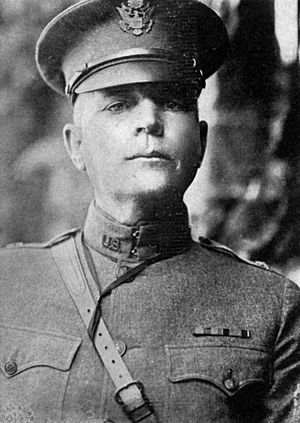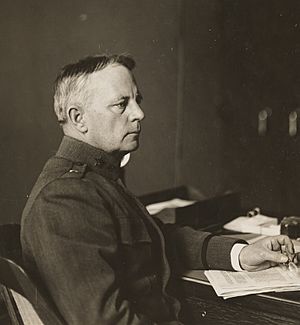Palmer E. Pierce facts for kids
Quick facts for kids
Palmer Eddy Pierce
|
|
|---|---|

Pierce in 1919, as the commander of the 27th Infantry Division
|
|
| Born | October 23, 1865 Savannah, Illinois, U.S. |
| Died | January 17, 1940 (aged 74) New York City, New York, U.S. |
| Buried |
United States Military Academy Post Cemetery, West Point, New York, U.S.
|
| Allegiance | |
| Years of service | 1891–1930 |
| Rank | Brigadier general (at time of retirement) |
| Battles/wars | Spanish–American War |
| Awards |
|
| Spouse(s) | Agnes Young Pierce |
| Other work | First President of NCAA Assistant to President of the Standard Oil Company |
Palmer Eddy Pierce (born October 23, 1865 – died January 17, 1940) was an important figure in both the United States Army and college sports. He became a brigadier general and led soldiers during World War I. He is also known for being the very first president of the National Collegiate Athletic Association (NCAA), which is a big organization for college sports today.
Contents
Early Life and Education
Palmer E. Pierce was born in Savanna, Illinois. He grew up in Traer, Iowa. He went to Grinnell College and then to the US Military Academy at West Point, New York. He finished his studies there in 1891.
After graduating, he worked as the athletic director at West Point for a short time. He even helped manage the first-ever Army football team.
Early Military Service and Sports Leadership
Pierce began his military career by serving in the Spanish–American War in 1898. He also served during the Boxer Rebellion in 1899. He continued his military training, graduating from advanced schools like the Army War College.
In 1906, Palmer Pierce became the first president of the NCAA. This organization was created to help manage and improve college sports. At the first meeting, he talked about "home rule." This meant that colleges joining the NCAA could still make many of their own decisions. He believed that sports rules needed to be fair and keep players safe. He felt that some old rules had made sports too rough.
He also served in the Villa Expedition in 1916.
World War I Service
In 1917, when the United States entered World War I, Pierce became an assistant to the Secretary of War, Newton D. Baker. He helped plan how the War Department would spend money to prepare for the war. He once explained that the money was needed for things like "clothing, cots, camps, food, pay." He also mentioned that soldiers might need to go to France.
Later in 1917, Pierce became the Director of Purchases for the War Industries Board. This board helped make sure the military had all the supplies it needed.
From late 1917 to early 1918, Pierce commanded the 27th Infantry Division and the 54th Infantry Regiment. During this time, he worked with British forces. He was involved in the Battle of Bellecourt. He learned valuable lessons from the Australian soldiers, who even provided hot meals to the front lines.
In late 1918, he became the Assistant Chief of Staff for the American Expeditionary Forces (AEF). He was promoted to brigadier general. For his brave actions and leadership, he received two Distinguished Service Medals from the U.S. Army. He also received the British Order of the Bath.
Later Life and Legacy
After he retired from the Army, Palmer Pierce worked as an assistant to the President of the Standard Oil Company.
He passed away in New York City on January 17, 1940. His wife, Agnes Young Pierce, later left a large gift of $1 million to the Association of Graduates of West Point. This money was used to create the Palmer E. Pierce Memorial Fund, which helps support West Point.


